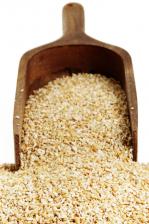Are Steel Cut Oats Healthier?
Does it matter what kind of oatmeal you eat? Find out how steel cut, regular, and instant oatmeal stack up nutritionally.
Several of you have written with questions about oats and oatmeal—in particular, whether steel-cut (or Irish) oats are healthier or more nutritious than regular oats. I think some of you will be surprised by the answer.
What’s the Difference Between Steel Cut and Regular Oats?
First, a quick guide to how different types of oat cereals are produced:
Oat groats: All types of oat cereals start out as groats, which are hulled, toasted oat grains. (Removing the hull doesn’t remove the bran, by the way.)
Steel-cut (Irish) oats: These are the least processed type of oat cereal. The toasted oat groats are simply chopped into chunks about the size of a sesame seed.
Stone-ground (Scottish) oats: These are the same as Irish oats but they are ground into smaller pieces, closer to the size of a poppy seed. Both Irish and Scottish oats have to be cooked before you eat them. Irish oats take about 45 minutes to cook, Scottish oats about half that long (because they are smaller).
Old-fashioned rolled oats: These are made by steaming the toasted groats and then running them between rollers to create flakes. Rolled oats can be eaten as is or cooked into oatmeal (it takes about ten minutes).
Quick-cooking oats: These are simply rolled into thinner flakes, so they cook a little faster.
Instant oats: These are the most heavily processed. The groats have been chopped fine, flattened, pre-cooked, and dehydrated. Instant oatmeal usually has added salt and sugar. I suggest leaving the instant oats on the shelf. In the time it takes you to boil the water to make instant oatmeal, you can cook some old-fashioned oats in the microwave. Here’s how.
Are Steel Cut Oats Healthier?
Because they go through some extra processing steps, you might assume that rolled oats would be less nutritious than steel-cut oats, but it turns out that the differences are quite minor. Steel cut, stone-ground, old-fashioned, and quick-cooking rolled oats are all made from whole grains and they all have approximately the same amount of fiber, protein, calories, and other nutrients.
In particular, oats are a good source of soluble fiber. As I explained in a previous article, soluble fiber can help reduce cholesterol and helps keep blood sugar levels steadier—which is helpful for managing and preventing diabetes as well as keeping your appetite in check.
Do Steel Cut Oats Have a Lower Glycemic Impact?
You might expect the glycemic load of steel cut oats to be a lot lower than that of rolled oats. However, the differences are really not that big.
Another thing to consider with any grain– or carbohydrate-based food is its glycemic impact. I’ve talked about glycemic impact in previous articles. In a nutshell, the glycemic impact is the speed at which a food is digested and converted into blood sugar. Foods that have a lower glycemic load are more slowly converted into blood sugar. When it comes to your blood sugar, lower and slower are generally better.
Because steel cut oats are so much chewier and denser and also somewhat less processed than rolled oats, you might expect that their glycemic load would be lower. Again, however, the differences are really not that big. Steel cut, stone ground, and rolled oats are all in the same ballpark as far as glycemic load goes.
What About the Glycemic Impact of Instant or Quick-Cooking Oats?
The glycemic load of quick-cooking and instant oats, however, is quite a bit higher than that of rolled or steel-cut oats. That means that a bowl of quick-cooking or instant oats might not keep you satisfied for as long as rolled or steel-cut oats would. Nonetheless, as long as you stay away from the ones with the added sugar, quick-cooking and instant oatmeal are still considered low-glycemic carbohydrates.
What Is the Serving Size of Oats?
And, of course, portion size is also a very big factor in the glycemic load of foods. A serving of oats is one third of a cup of rolled oats, one quarter of a cup of steel cut oats, or about three quarters of a cup of cooked oatmeal.
Are Oats a Healthy Choice for Breakfast?
As far as breakfast cereal goes, any type of plain, unflavored oat cereal is a good choice. All are made from minimally processed whole grains and, unlike most of the options in the cereal aisle, have no added sugar. Although a bowl of oatmeal contains four or five grams of protein, it’s mostly carbohydrates. As I talk about in my book, Secrets for a Healthy Diet, adding more protein to your breakfast, such as some eggs, milk, nuts, or yogurt, is another way to make breakfast go a little farther.
Which Type of Oatmeal is Best?
The biggest differences between steel-cut, stone-ground, and rolled oats are in the texture and the cooking time. So, it really just comes down to which type you prefer—and how much time you have to cook them. If you like a very hearty, chewy cereal, you might enjoy steel-cut oats. But you’re not losing out on anything nutritionally by choosing old-fashioned rolled oats instead.
Keep in Touch
If you have a suggestion for a future show topic or would like to find out about having me speak at your conference or event, send an email to nutrition@quickanddirtytips.comcreate new email. You can also post comments and questions on my Nutrition Diva Facebook Page. I answer a lot of listener questions in my free weekly newsletter, so if you’ve sent a question my way, be sure you’re signed up to receive that.
Have a great week and remember to eat something good for me!
RESOURCES:
Everything You Ever Wanted to Know About Oats (Former Fat Guy Blog)
Nutrition Facts for Oatmeal (NutritionData.com)
Glycemic Information for Oatmeal (GlycemicIndex.com)
Steel Cut Oats image from Shutterstock



